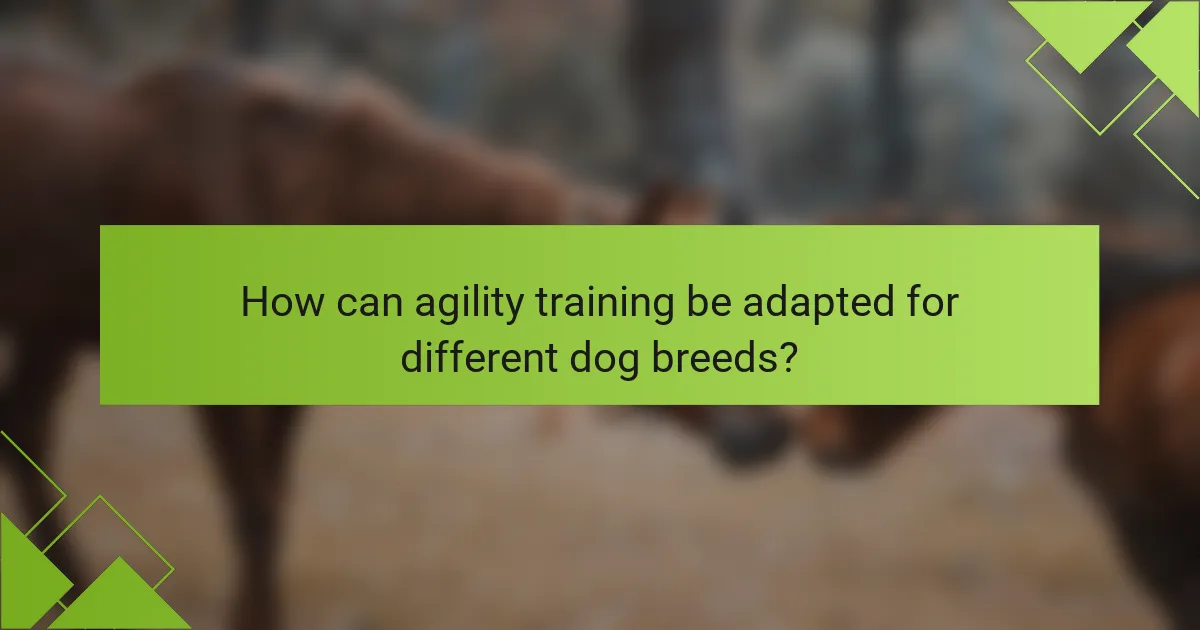Agility training for dogs enhances physical fitness, mental stimulation, and owner-dog bonds. This article covers the key components, benefits, and essential equipment needed for effective training. It also discusses breed-specific adaptations and the importance of monitoring progress. Finally, resources for further learning will be highlighted.

What are the key components of agility training for dogs?
Agility training for dogs involves several key components: obstacles, handling techniques, and conditioning exercises. Obstacles include jumps, tunnels, and weave poles that enhance physical skills. Handling techniques teach owners how to guide their dogs effectively through courses. Conditioning exercises improve strength, flexibility, and endurance, ensuring dogs can perform optimally.
How does agility training enhance a dog’s physical fitness?
Agility training significantly enhances a dog’s physical fitness by improving strength, endurance, and coordination. This type of training engages multiple muscle groups, promoting overall health and preventing obesity. Additionally, agility training increases cardiovascular fitness, allowing dogs to sustain higher energy levels during activities. As a result, dogs become more agile and responsive, enhancing their ability to navigate obstacles efficiently.
Which skills are developed through agility training?
Agility training develops skills such as coordination, speed, balance, and focus in dogs. These skills enhance overall physical performance and mental engagement. Improved coordination helps dogs navigate obstacles effectively. Speed training increases their quickness in response to commands. Balance exercises promote stability, while focus activities strengthen their ability to concentrate during tasks. These attributes contribute to a well-rounded, responsive canine athlete.
What are the common obstacles used in agility training?
Common obstacles used in agility training include jumps, tunnels, weave poles, seesaws, A-frames, and dog walks. Each obstacle challenges a dog’s speed, coordination, and problem-solving skills. Jumps vary in height and width, while tunnels test a dog’s confidence and drive. Weave poles enhance agility and precision, and seesaws promote balance. A-frames and dog walks develop climbing skills and encourage dogs to navigate heights.

What benefits does agility training provide for dogs?
Agility training provides numerous benefits for dogs, including improved physical fitness, enhanced mental stimulation, and strengthened owner-dog bonds. This training promotes agility, coordination, and balance, which are essential for a dog’s overall health. Additionally, it can help reduce behavioral issues by channeling excess energy into structured activities. Dogs engaged in agility training often exhibit increased confidence and socialization skills, making them more adaptable in various environments.
How does agility training improve a dog’s mental stimulation?
Agility training significantly enhances a dog’s mental stimulation by engaging their problem-solving skills and focus. This training requires dogs to navigate obstacles, which promotes cognitive development. Additionally, the variety of challenges keeps their interest high, reducing boredom and anxiety. As a result, dogs develop better impulse control and adaptability, leading to improved overall behavior.
What impact does agility training have on a dog’s behavior?
Agility training significantly enhances a dog’s behavior by improving focus, reducing anxiety, and fostering better social interactions. This training encourages mental stimulation and physical exercise, leading to a well-adjusted and obedient pet. As a result, dogs often exhibit increased confidence and reduced behavioral issues.
How can agility training strengthen the bond between dog and owner?
Agility training strengthens the bond between dog and owner by promoting teamwork and communication. Engaging in this activity enhances trust, as dogs learn to rely on their owners for guidance. Owners gain a deeper understanding of their dog’s strengths and weaknesses, fostering a closer relationship. Additionally, the shared experience of training and achieving goals together builds mutual respect and affection.

What equipment is essential for agility training?
Essential equipment for agility training includes jumps, tunnels, weave poles, and contact obstacles. These tools enhance a dog’s speed, coordination, and overall agility. Jumps come in various heights, allowing for customized training. Tunnels encourage dogs to navigate through enclosed spaces, promoting confidence. Weave poles improve a dog’s ability to change direction quickly. Contact obstacles, like A-frames and seesaws, build strength and balance. Together, these elements create a comprehensive agility training experience.
Which types of jumps are commonly used in agility training?
Commonly used jumps in agility training include the bar jump, tire jump, and broad jump. These jumps enhance a dog’s coordination, speed, and jumping technique.
Bar jumps consist of a horizontal bar supported by two vertical posts, promoting precision in jumping. Tire jumps feature a suspended tire that dogs must leap through, improving their focus and agility. Broad jumps require dogs to leap over a distance, fostering strength and confidence.
Incorporating these jumps into training routines can significantly boost a dog’s performance in agility competitions.
What are the different forms of tunnels and their uses?
Agility training for dogs includes various forms of tunnels, primarily used to enhance speed, coordination, and confidence. The main types of tunnels are open tunnels, collapsed tunnels, and rigid tunnels.
Open tunnels are straight tubes that allow dogs to run through freely, promoting speed and agility. Collapsed tunnels have a flexible structure that challenges dogs to navigate through a narrower space, enhancing their problem-solving skills. Rigid tunnels are sturdy and maintain their shape, often used in competitive settings to ensure consistency in training.
Each tunnel type serves to improve different agility skills, making them essential tools in agility training for dogs.
How do weave poles function in agility training?
Weave poles function in agility training by helping dogs develop speed, coordination, and focus. They require dogs to navigate through a series of vertical poles in a zigzag pattern, enhancing their ability to change direction quickly. This exercise builds muscle memory and improves overall agility skills. Regular practice with weave poles can significantly increase a dog’s performance in agility competitions.

How can agility training be adapted for different dog breeds?
Agility training can be adapted for different dog breeds by considering their physical attributes and temperaments. Breeds with high energy levels, like Border Collies, benefit from intense agility routines, while smaller breeds, such as Dachshunds, may require modified equipment to accommodate their size.
Training sessions should be tailored to each breed’s unique capabilities. For example, larger breeds may excel in jumping and running, while smaller breeds might focus on precision and maneuverability. Additionally, incorporating breed-specific exercises can enhance engagement and performance.
It’s essential to monitor the dog’s progress and adjust the training intensity and complexity based on their response. This ensures that all breeds, regardless of size or energy level, can enjoy and excel in agility training.
What considerations are there for small breed dogs in agility training?
Small breed dogs require specific considerations in agility training to ensure their safety and success. Focus on equipment size, as obstacles must be proportionate to their smaller stature. Training intensity should match their energy levels, with shorter sessions to prevent fatigue. Additionally, monitor their physical health closely, as small breeds may be more prone to injuries. Tailoring techniques to their unique attributes can enhance their agility performance.
How does agility training differ for large breed dogs?
Agility training for large breed dogs focuses on their unique physical attributes and capabilities. These dogs often require modified equipment and techniques to ensure safety and effectiveness. For instance, larger jumps and wider tunnels accommodate their size, while training sessions may emphasize stability and control. Additionally, large breeds may benefit from a slower introduction to agility to prevent injury and build confidence.

What are the best practices for starting agility training with your dog?
To start agility training with your dog, focus on gradual introduction, basic commands, and positive reinforcement. Begin with simple obstacles, ensuring your dog is comfortable and engaged. Consistency and patience are key for success.
1. Choose a safe, distraction-free environment.
2. Introduce basic commands like “jump” or “weave.”
3. Use treats and praise to encourage your dog.
4. Gradually increase the difficulty of obstacles.
5. Keep training sessions short and fun.
6. Monitor your dog’s physical condition to prevent injury.
How can you ensure safety during agility training sessions?
To ensure safety during agility training sessions, implement these key practices. Use appropriate equipment to prevent injuries. Ensure the training area is free of hazards and has sufficient space. Always warm up dogs before training to prevent strains. Monitor your dog’s health and behavior closely for any signs of discomfort.
What training methods are most effective for beginners?
Positive reinforcement, consistency, and gradual progression are the most effective training methods for beginners in agility training for dogs. These techniques encourage learning and build confidence.
1. Positive reinforcement: Rewarding desired behaviors with treats or praise enhances motivation.
2. Consistency: Using the same commands and cues helps dogs understand expectations.
3. Gradual progression: Starting with simple obstacles and increasing complexity prevents frustration.
These methods foster a strong bond between the dog and handler, making training enjoyable.
What common mistakes should be avoided in agility training?
Common mistakes to avoid in agility training include inconsistent practice, neglecting the dog’s physical condition, and skipping warm-ups. Failing to use proper equipment can also hinder progress. Additionally, not providing enough mental stimulation can lead to boredom and disengagement. Prioritize consistency, fitness, and engagement for effective training.

What role do competitions play in agility training for dogs?
Competitions play a crucial role in agility training for dogs by providing motivation and measurable goals. They enhance a dog’s skills, focus, and teamwork with their handler. Additionally, competitions foster a sense of achievement and can improve the bond between the dog and owner. Engaging in competitive events also offers exposure to different environments, which can further enhance a dog’s adaptability and performance.
How can competition experience benefit your dog’s agility skills?
Competition experience significantly enhances a dog’s agility skills by providing real-world practice and exposure. It fosters confidence and improves focus, as dogs learn to navigate obstacles under pressure. The competitive environment encourages faster decision-making and better handling by the handler. Additionally, social interaction with other dogs can improve overall performance and motivation. Regular competition helps in identifying strengths and weaknesses, allowing for targeted training adjustments.
What are the different levels of agility competitions available?
Agility competitions for dogs vary in levels, including novice, intermediate, and advanced categories. Each level tests different skills and complexities. Novice competitions focus on basic obstacle navigation, while advanced levels incorporate intricate courses requiring higher precision and speed.
How do you prepare your dog for an agility competition?
To prepare your dog for an agility competition, start with consistent training and practice sessions. Focus on building your dog’s confidence and familiarity with the equipment. Ensure proper warm-up exercises to prevent injuries. Incorporate varied courses to enhance adaptability. Lastly, maintain a positive environment to keep your dog motivated and engaged.

What resources are available for further learning in dog agility training?
Various resources are available for further learning in dog agility training, including books, online courses, and local clubs. Books like “Agility Right from the Start” offer foundational techniques. Online platforms such as Udemy provide structured courses for different skill levels. Joining local agility clubs can facilitate hands-on training and community support. Additionally, YouTube channels dedicated to dog training offer visual demonstrations and tips. These resources enhance understanding and skills in agility training for dogs.
Which online platforms offer agility training courses?
Online platforms offering agility training courses for dogs include Zoom, Udemy, and PetSmart. These platforms provide a variety of courses focusing on techniques, equipment, and training methods. Additionally, local training centers may offer online sessions to enhance accessibility.
What books are recommended for understanding agility training techniques?
Several books are recommended for understanding agility training techniques for dogs. “Agility Training for Dogs” by Mary Ann Simonds provides comprehensive insights into training methods and equipment. “The Agility Advantage” by Julie Daniels focuses on developing skills and handling techniques. “Agility Right from the Start” by Eva Bertilsson and Emelie Johnson Vegh emphasizes foundational skills for beginners. “Clean Run’s Agility Training” by the Clean Run staff offers practical exercises and training plans. These resources cover various aspects of agility training, including techniques, benefits, and necessary equipment.
How can local clubs enhance your agility training experience?
Local clubs significantly enhance agility training experiences by providing structured environments and expert guidance. They offer opportunities for socialization, skill development, and access to specialized equipment. Additionally, clubs often organize competitions that motivate participants and foster community engagement. Joining a local club can lead to improved performance and a deeper understanding of agility techniques.
What expert tips can help optimize your dog’s agility training?
To optimize your dog’s agility training, focus on consistency, positive reinforcement, and gradual progression. Incorporate a variety of obstacles to maintain engagement and improve skills. Regularly assess your dog’s performance and adjust training techniques accordingly. Ensure that training sessions are short and enjoyable to prevent fatigue and frustration.
